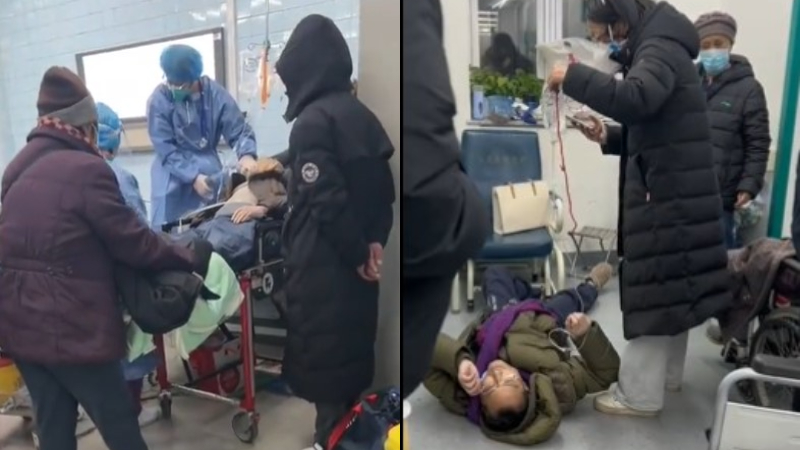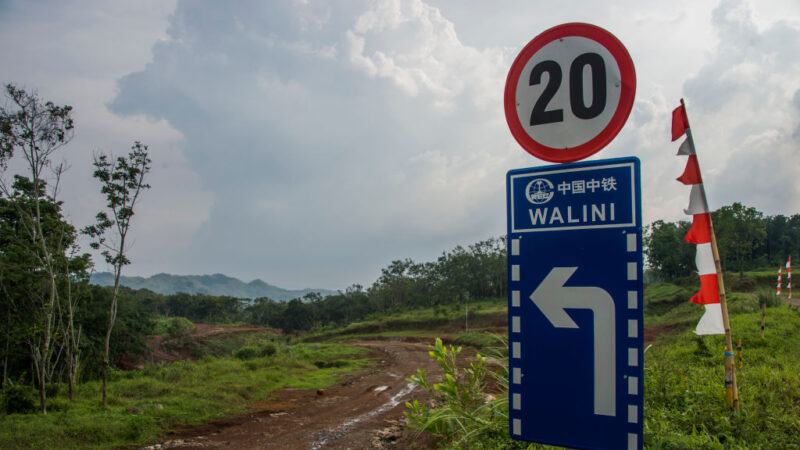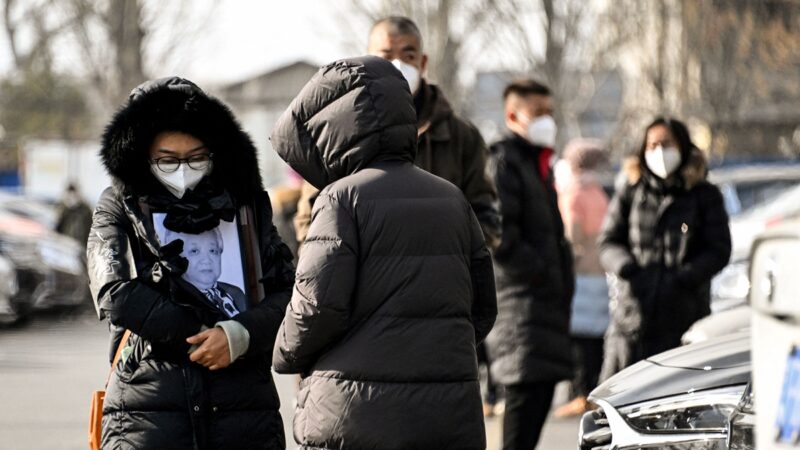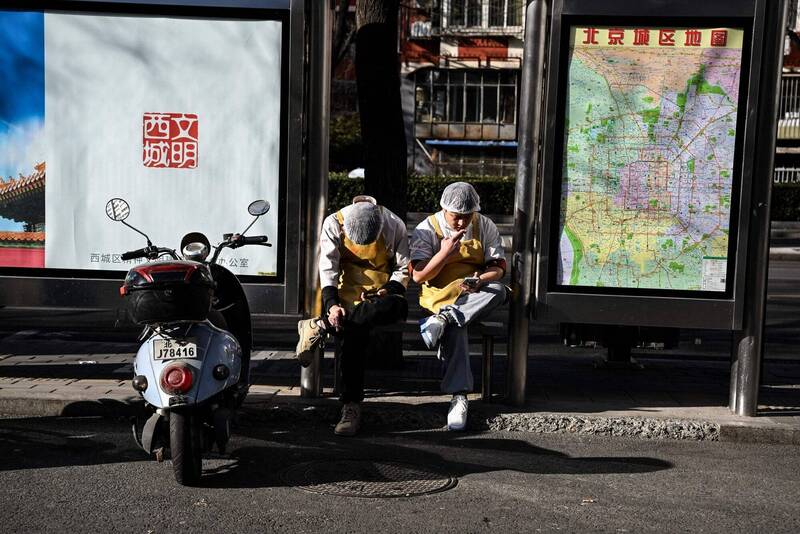The Jakarta-Bandung high-speed rail with a total length of 142.3 kilometers, manufactured by Chinese technology, is an index project of China's "Belt and Road" plan in Indonesia. A few days ago, an engineering train derailed during the construction of the Jakarta-Bandung high-speed railway, killing 2 Chinese workers and injuring 4 others. The authorities ordered a temporary suspension of work to investigate the cause of the accident. Members of the Indonesian Congress said that the Jakarta-Bandung high-speed railway has many accidents and requires the government to re-examine the plan.
The Jakarta-Bandung high-speed railway connects the two major cities of Jakarta and Bandung. It is the first high-speed railway in Southeast Asia.
The Central News Agency reported that Kereta Cepat Indonesia China (KCIC), which is responsible for the construction of the Jakarta-Bandung high-speed railway, confirmed to the media on 19 December 2022 that a working train derailed at around 5 pm on the 18th, resulting in the death of two skilled foreign workers. .
KCIC told The Jakarta Post in a statement: "KCIC has been coordinating with relevant parties to deal with this incident and has been cooperating with the authorities' investigation of the incident."
Adita Irawati, spokesperson for the Indonesian Ministry of Transport, said in a press release that the accident has caused a total of six deaths and injuries, including two deaths and four minor injuries. The Indonesian newspaper Tempo reported today that KCIC chief executive Dwiyana Slamet Riyadi said that the six people were all Chinese citizens, and the seriously injured were still receiving treatment in hospital.
After this industrial safety incident, the Ministry of Communications ordered the Jakarta-Bandung high-speed railway to temporarily suspend work. Adita pointed out that "according to the relevant regulations, the construction will be temporarily stopped for further investigation." Once the investigation is completed, a proposal will be prepared as a guideline on how to improve the safety of the high-speed rail construction plan.
In response to this accident, members of Congress and experts called on the Indonesian government to re-examine the safety of the Jakarta-Bandung high-speed rail project. Suryadi Jaya Purnama, a member of Congress of the Islamic Prosperity Justice Party (PKS), said in an interview with Central News Agency: "The Indonesian government should re-examine the Jakarta-Bandung high-speed rail plan and renegotiate."
Suryadi said that before the project, the gas pipeline of Indonesia's state-owned oil company (Pertamina) was damaged and exploded. There were also accidents such as bridge piers collapsed during the removal process and two excavators were knocked down. He asked the police to investigate the cause of the accident in detail, and KCIC must be responsible for the accident, and implement safety regulations in every subsequent work.
Aditya Dwi Laksana, an observer for the Indonesian Transport Association (MTI), pointed out that in this case, the completion deadline must be extended. He believes the accident stemmed from KCIC's rush to complete the project by the June 2023 deadline.
This industrial safety accident also represents another setback for China's "Belt and Road" initiative in Indonesia. Earlier, the completion date of the Jakarta-Bandung high-speed rail has been continuously delayed. It was originally scheduled to be completed in 2019, but it was postponed to 2023 due to issues such as the epidemic and land acquisition. Also, cost overruns are highly controversial.
China initially proposed the Jakarta-Bandung high-speed railway at a cost of US$5.5 billion (approximately NT$169.2 billion), which was guaranteed to require no funding or guarantee from the Indonesian government. It was later increased to about US$6 billion, with a loan from the China Development Bank75 %, the repayment period is 40 years, and the grace period is 10 years. Indonesian Chinese high-speed rail company will raise 25%.
However, as the project was delayed, the Indonesian government was finally forced to invest in the budget. According to local media, the current cost of the Jakarta-Bandung high-speed rail project has reached 7.5 billion US dollars.
Experts reveal the purpose of the CCP’s unblocking: Early infection and early death
Image : On 20 December 2022, a woman in Beijing holds photos of her relatives outside a funeral home. (Noel Celis/AFP via Getty Images)
The CCP’s sudden and complete unblocking has led to a tsunami-like outbreak of the epidemic. Fever clinics in hospitals across the country are full, and there are long queues at funeral parlors. American experts said that in the next 90 days, about 60% of the Chinese people will be infected with the epidemic, and the death toll may reach millions. The CCP's sudden relaxation of epidemic control has a purpose, "infecting everyone who can be infected, and letting everyone who should die to die" to restore the economy as soon as possible.
News (13)
Expert: Within 90 days, millions of people in China will die from the epidemic
Voice of America reported on 21 December that Dr. Eric Feigl-Ding, a Chinese-American epidemiologist and public health expert, believed that the purpose of the CCP’s current relaxation of epidemic control is to “infect everyone who can be infected, and let everyone who dies be infected” as soon as possible, peak as early as possible, production resumes as soon as possible.”
Ding Liang is the co-founder of the World Health Network and is currently the head of the New England Institute of Complex Systems Research Task Force on COVID-19. He said that in the next 90 days, 60% of China's population, or 10% of the world's population, will be infected with covid, and the death toll may be as high as millions.
Earlier, on 15 December, The Economist released a model predicting that if the virus is allowed to rage, about 96% of China's population will be infected within the next three months, and 1.5 million Chinese are expected to die. People over the age of 60 will account for 90% of the deaths.
News (14)
Bodies of funeral parlours in many places in China continue to surge
After the Chinese Communist Party officially announced the new 10 epidemic prevention measures on 7 December, it suddenly relaxed the epidemic prevention and control, followed by a sharp increase in the number of infections. The Chinese capital, Beijing, experienced a serious medical run. A large number of infected patients rushed to the hospital for treatment, but many of them could not wait for a bed.
At the same time, the number of deaths in Beijing increased rapidly. Funeral homes and crematoria received a large number of remains, the freezers were full, and the cremation furnace "burned from morning to night."
Funeral homes in the eastern suburbs of Beijing were designated to accept and cremate patients who died of the epidemic. Ms. Li, a staff member of the funeral home, revealed to The Epoch Times on 14 December, "We have to burn 200 (remains) a day, and we can't even go home." Under normal circumstances, there are 30 or 40 corpses.
The incinerators of the 8 crematoriums in the eastern suburbs of the funeral home continued to emit white smoke 24 hours a day, and the appointments were completely full. Ms. Li said that it takes at least a week to wait for an appointment for cremation.
Beijing Babaoshan Funeral Home also saw long queues of corpse trucks. Mr. Lin, a staff member of the funeral home, told The Epoch Times, “Every day is very busy now. It has never been so busy. There are more people cremated every day than before. I can't take it."
Hong Kong's "Ming Pao" reported that funeral homes in Beijing currently have a backlog of more than 2,000 remains, and it is estimated that "they will not burn them all in a week."
Currently, this wave of epidemic tsunami is sweeping across China. In addition to Beijing, hospitals in Shanghai and Tianjin are also full and the number of deaths has increased sharply. Funeral parlors in Shenyang, Hebei, Henan, and Guangzhou are all overloaded.
On 18 December, a video was uploaded online showing corpses in the corridors and rooms of a hospital in Shenyang, Liaoning. The photographer said: "Director, this is the one who died last night, and it hasn't been taken away yet. There are 3 people in this one, and 4 people in this corridor. Then, here are 7 people, and there are 2 more dead people in this one." Did not pull away."
On the 19th, NTDTV interviewed a worker in the funeral service industry in Shenyang. He said that people died in the emergency departments of many hospitals, but there were no cars to pull people, and there was nowhere to store the bodies. "I went to the (emergency department) to pull it out", "Too many people died (too much), there is no way, too many."
He said, "It's the same in every hospital. In some hospitals, there are dozens, seven or eight corpses piled up, and the corpses are left there. There is no way, they can't be transported, and there is no way at all."
According to news on the Internet, many hospitals in Guangzhou also have a backlog of covi-positive corpses.
News (15)
Yokogawa: Two reasons prompted the CCP to change its epidemic prevention policy
Without warning, preparation, or planning, the CCP suddenly loosened its control over the epidemic, which led to the explosive growth and spread of the epidemic, resulting in a chaotic situation of running out of medical care, running out of funeral parlors, and shortage of medicines.
Yokogawa, a current affairs commentator based in the United States, analyzed in the "Elite Forum" program, "The 'blank paper revolution' should be one of the important reasons for the CCP to end the epidemic control. Because generally speaking, the CCP wants to adjust its policies, and it will avoid allowing People thought it was a concession to a popular protest."
In addition, according to WHO officials, the epidemic had already broken out before China loosened control. Yokogawa said, "The CCP may have gotten some information. If the city continues to be closed, it will not be able to prove the correctness of the 'dynamic clearing' epidemic prevention policy. Therefore, it is not the fault of the zero-covid policy if it is simply released at this time."
He believes that these two possibilities exist, and they may be superimposed, which led to the sudden change of the CCP's policy and the relaxation of epidemic prevention and control.
News (16)
Tang Jingyuan: The CCP deliberately pushed the infection peak to create a "man-made disaster"
However, the CCP’s release of epidemic prevention and control is the same as the zero-blocking policy, which puzzles the outside world. For example, in some places, the outbreak of the epidemic has caused serious medical shortages, while in some places, the epidemic has spread too slowly.
On December 16, it was revealed on the Internet that the Wuxi municipal government held a meeting to convey that the city was criticized by the Jiangsu provincial government for being "too slow" and ordered that the speed of infection must be accelerated, so that "most people will be infected with the virus" by March next year. once".
In addition to Wuxi City, Henan's medical system has also issued a notice that until the end of March next year, the province's health and health system will cancel holidays.
Tang Jingyuan, a current affairs commentator in the United States, analyzed that this shows that the CCP leadership intends to achieve mass infection before and after the "two sessions" in March next year and the change of government.
He told NTDTV that the CCP is deliberately pushing the peak of infection, which is completely different from the Western practice of "co-existing with the virus" to suppress the peak as much as possible, delay infection, and take care of vulnerable groups as much as possible. The CCP not only "laid back" and allowed the epidemic to break out, but also artificially created another "man-made disaster".
Tang Jingyuan believes that there is only one reason for the CCP to do this, and that is to hope to overcome the peak of the outbreak in the shortest possible time and realize the economic recovery plan.









No comments:
Post a Comment